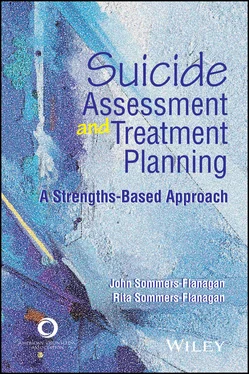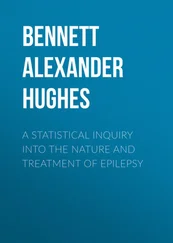John Sommers-Flanagan - Suicide Assessment and Treatment Planning
Здесь есть возможность читать онлайн «John Sommers-Flanagan - Suicide Assessment and Treatment Planning» — ознакомительный отрывок электронной книги совершенно бесплатно, а после прочтения отрывка купить полную версию. В некоторых случаях можно слушать аудио, скачать через торрент в формате fb2 и присутствует краткое содержание. Жанр: unrecognised, на английском языке. Описание произведения, (предисловие) а так же отзывы посетителей доступны на портале библиотеки ЛибКат.
- Название:Suicide Assessment and Treatment Planning
- Автор:
- Жанр:
- Год:неизвестен
- ISBN:нет данных
- Рейтинг книги:4 / 5. Голосов: 1
-
Избранное:Добавить в избранное
- Отзывы:
-
Ваша оценка:
- 80
- 1
- 2
- 3
- 4
- 5
Suicide Assessment and Treatment Planning: краткое содержание, описание и аннотация
Предлагаем к чтению аннотацию, описание, краткое содержание или предисловие (зависит от того, что написал сам автор книги «Suicide Assessment and Treatment Planning»). Если вы не нашли необходимую информацию о книге — напишите в комментариях, мы постараемся отыскать её.
Suicide Assessment and Treatment Planning — читать онлайн ознакомительный отрывок
Ниже представлен текст книги, разбитый по страницам. Система сохранения места последней прочитанной страницы, позволяет с удобством читать онлайн бесплатно книгу «Suicide Assessment and Treatment Planning», без необходимости каждый раз заново искать на чём Вы остановились. Поставьте закладку, и сможете в любой момент перейти на страницу, на которой закончили чтение.
Интервал:
Закладка:
Again, there are individual, agency, and professional variations in how clients or students can interact with professionals within the frame of social media. In some cases, it may be an important clinical tool to be used to extend care, but if so, it should be used for specific purposes and professional/personal boundaries should be clear. In other cases, it can be both invasive and worrying to have clients reach out to you via social media.
Emergency Procedures
Emergency procedures should be described in your informed consent document. Your description may be as simple as “In cases of emergency, you should call 911 immediately.” When discussing emergency procedures with youth, you might say something like the following:
If you’re feeling suicidal, it’s important to have a positive plan for what to do. Of course, you can call 911 or go to the nearest emergency room. You can also call the National Suicide Prevention Lifeline (1-800-273-TALK—a new 988 number for mental health emergencies will be available in 2022) or text the Crisis Text Line (text HOME to 741741 to connect with a crisis counselor). I’m also interested in your ideas about what you would like to do if you’re in a crisis. We can talk more about that today.
Creating a collaborative safety plan is an essential clinical skill. We provide guidance on this in Chapter 9.
Ethical Issues Pertaining to Suicide in Online and Other Distance Counseling Formats
Coronavirus-related economic shutdowns, social distancing, and other contemporary factors have quickly increased the use of counseling online and in other distance formats. Going by the names telehealth , telemental health , and telebehavioral health , these counseling platforms follow the same ethics codes and state and federal regulations as face-to-face counseling. However, attention to specific details with regard to informed consent, confidentiality and privacy issues, and emergency procedures is particularly salient when working with clients who are suicidal (Stoll et al., 2020).
Most online, telephonic, or text-based ethical issues in counseling are best addressed by counselor preparation and a clear and thorough informed consent process. Before engaging clients in distance counseling, address the following issues in writing and, when possible, via oral or text-based discussion:
Before meeting, do a preparation and competence check, including the following:Learn to use a counseling platform that is compliant with the Health Insurance Portability and Accountability Act of 1996 and has adequate data security and storage.Establish a clear and secure online payment system.Develop an electronic informed consent form that clients can review and sign before or at the beginning of counseling.
Collect information in advance about your client, including identifying information, best contact methods, a home address or location, a personal contact in case of emergency, and contact information of local emergency personnel (e.g., law enforcement, child protective services).
Describe your strong preference to openly discuss suicide and to work collaboratively, even when clients are in suicidal crisis.
Make sure your clients know what specific behaviors will prompt an emergency response (e.g., if clients call or text and leave a message that they are suicidal, or if clients hang up or go offline after making a suicide threat).
Make sure you and your clients agree to an emergency plan (e.g., “I will contact the police and give them your address or your last known location”).
Confidentiality is limited when you are using video, online, or telephonic counseling modalities. In particular, you may not be able to ascertain whether your client is in a setting that affords privacy; other people may be present and able to hear or see counseling interactions. In addition, when using text-based platforms, you face the possibility of identity theft—you may not know whether you are really interacting with your client. One method of addressing these limitations to confidentiality is to establish a prearranged challenge question (Rummell & Joyce, 2010).
Directly discussing confidentiality strategies with your clients is recommended. Keep in mind that online and telephonic counseling can be equivalent to face-to-face counseling, but typically the factors that make online approaches effective include (a) establishing and maintaining a therapeutic relationship and (b) implementing evidence-based counseling strategies (Castro et al., 2020; Hanley & Reynolds, 2009). The Zur Institute has a complete comparative list of ethics guidelines pertaining to telehealth counseling across 14 disciplines/organizations, including ACA, the American Psychological Association, the National Association of Social Workers, and the National Board for Certified Counselors (see https://www.zurinstitute.com/ethics-of-telehealth/).
Boundary Setting and Tending
Professional boundaries are a part of all counseling. Appropriate boundaries help clarify the nature of your relationship and aid in establishing and maintaining therapeutic relationships. This is especially true when you are working with clients who may be suicidal. When regularly working with suicidality you might become more easily burned out, your judgment may become impaired, your buttons may get pushed, and in general you may feel increased vulnerability.
Clear boundary setting protects counselors and clients. Boundaries define the parameters of the professional relationship and model clarity, safety, and compassion. The hard truth for all mental health professionals is this: We cannot save people from pain or prevent them from making destructive choices. We can work with people to make changes in their lives—changes that reduce pain and increase joy, changes that may begin a positive momentum—but there are limits, and these limits should be carefully described and observed (see Case Vignettes 2.1and 2.2).
The Lily and Brian scenario in Case Vignette 2.1may seem extreme, but in our years of teaching, supervising, and working with difficult populations, we have seen similar (and worse) boundary extensions or breaks (R. Sommers-Flanagan et al., 1998). In telebehavioral health scenarios involving suicidality, you may get many requests to provide immediate assistance via text or telephone. If you respond to such requests with anything that can be construed as providing counseling, you have broken a boundary and begun counseling without establishing informed consent. Whenever clients are suicidal, the temptation to break professional boundaries can be powerful.
Specific circumstances or job demands may require you to give clients your cell phone number or email address, but beware of the implicit messages that accompany this boundary extension. You become responsible for whatever information is communicated through these channels. What are your boundaries for the number of calls a day, or the number of minutes for each call, or the number and length of emails or texts you are willing to read and respond to? Setting and maintaining nuanced boundaries can become slippery. We cannot tell you exactly which boundaries to set, because professional and community norms vary. Our best guidance is for you to consult, read your professional ethics codes, contemplate, and consult again. One more guideline: If you are reluctant to openly consult with colleagues about how you are handling boundaries with clients, then you should probably consult with your colleagues.
Case Vignette 2.1 Beyond the Boundaries
Years ago, a kind young volunteer named Lily was working at a homeless shelter. She became close to Brian, a man about her age who struggled with bipolar disorder. Lily was married and had a toddler at home. She spent many hours talking with Brian, trying to convince him to take his medications and get into a rehabilitation program that would train him for entry-level jobs. She was making headway. Brian became med compliant and went on his first job interview, but it did not go well.
Читать дальшеИнтервал:
Закладка:
Похожие книги на «Suicide Assessment and Treatment Planning»
Представляем Вашему вниманию похожие книги на «Suicide Assessment and Treatment Planning» списком для выбора. Мы отобрали схожую по названию и смыслу литературу в надежде предоставить читателям больше вариантов отыскать новые, интересные, ещё непрочитанные произведения.
Обсуждение, отзывы о книге «Suicide Assessment and Treatment Planning» и просто собственные мнения читателей. Оставьте ваши комментарии, напишите, что Вы думаете о произведении, его смысле или главных героях. Укажите что конкретно понравилось, а что нет, и почему Вы так считаете.











